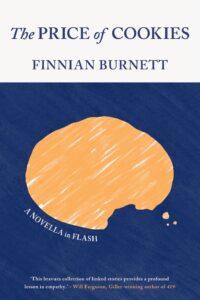Community in short, short form
The Price of Cookies
by Finnian Burnett
Toronto: Off Topic Publishing, 2024
$15.00 / 9781738988525
Reviewed by Brett Josef Grubisic
*

The short story is an open-ended form. Only to a degree, though. Too long and it becomes a novelette (≈ 7,500-17,500) or novella (≈ 20,000-40,000 words). Fill out additional belt notches and—presto chango—a novel is born. If there’s a name for the piece that’s 17,501-19,999 words, I don’t know what it is. Novelino? Noveling?
Boundaries (and jesting) aside, with stories there’s also a crucial practical consideration: publication.
In Canada, new writers quickly learn where to submit the short fiction they’ve sweated over; of necessity, they read the small print of How to Submit pages, with each literary journal unique for its musts and must nots.
“Any submissions longer than 3,000 words are not likely to be accepted,” warns one. “To a maximum of 3,500 words,” another declares. “Our preferred length for submissions is 4,000 words or less,” a third states. And so on: “one short story (maximum 5,000 words),” “We rarely publish pieces longer than 6,000 words,” “Fiction submissions may be up to 8,000 words in length,” “Maximum word count for Fiction and Non-Fiction: 10,000 words.”
The writer with the 12,000-word heavyweight will understand immediately that publications venues for their baby are few and far between.
The short, short story is a different, er, story.
A genre around for eons that received a makeover as “flash fiction” in the ‘90s and loosely defined as a story 1,000 words and less—or 1,500 and less, depending on who’s asked—it coexists with bite-sized cousins and siblings.
There’s the 50-word dribble/minisaga; the 100-word drabble/micro fiction; the 250-word postcard story; and 750-word sudden fiction; somewhere among those stands nanofiction, which may or may not be exactly 55 words in length.
The puniest, Twitterature, began as stories of 140 characters; it branched out to 280 characters in 2017 (and did not change to Xerature in 2023).
A legendary 8-syllable wonder—“For sale: baby shoes, never worn”—iffily attributed to Ernest Hemingway, who supposedly won a $10 bet by writing a 6-word story, is regularly called a short, story story, which suggests the porousness of categories above. Technically, I suppose it’s Twitterature avant la lettre.
Writers of short, short stories might not encounter much sizeism. The aforementioned literary magazines state maximums, not minimums.
With that said, purists may argue that a short, short story isn’t a real story. It’s too short. Edgar Allan Poe posited that a short story should be read in one sitting, anywhere from a half hour to two hours. And in general internet authorities refer to the 1000-word cut-off: fall below it, dear author, and despite your protests, you have not composed a short story.
Online experts outline the genre’s prerequisites. For instance: brevity, a complete plot, and surprise. Plus, strong imagery, active voice, and powerful verbs. Add to that: a single setting and time frame; beginning in medias res; few background details; ambiguity. And: poetic, experimental, precise. Also, this goal: “To show the reader the change in a character as they grapple with conflicts.”
In other words, a short, short story might be experimental and ambiguous. Or feature active verbs and a surprise. Anything goes, it seems, provided that the author keeps an eye on brevity—that’s the extra “short” in “short, short story.”
* * *
Now that context is out of the way, how about a review? What’s the fitting size for a book composed of 26 stories that average 1.3 pages each? Proportional brevity, you’d think! And, also, what are the standards of measurement, of assessment? What, in other words makes for an exemplary, a so-so, or an ineffective short, short story? Despite my scouring, internet experts remained mum on the art of evaluating short, short fiction.

The Price of Cookies, by Princeton-based Finnian Burnett, suggested a couple of possibilities. The short, short review version is this: “The Price of Cookies showcases Finnian Burnett’s flair for devising characters that struggle to cope with personal burdens that life has dealt them. Cookies leaves the reader wanting more. Unfortunately, the author doesn’t supply it.”
Gauging by online esteem, George Saunders’ “Sticks” (1995) is the short, short story to beat, or at least measure up to. It’s exemplary.
Compared to Saunders’ opener—“Every year Thanksgiving night we flocked out behind Dad as he dragged the Santa suit to the road and draped it over a kind of crucifix he’d built out of metal pole in the yard.”—the first sentence of Burnett’s title story is simple—one clause, no adjectival or tonal fireworks, a statement that establishes an action and a setting: “The boy wandered the aisles of the shop and the clerk watched.” Within the story’s single page, though, Burnett (The Clothes Make the Man) creates an intense episode and satisfying resolution. The teenage boy is acting out by shoplifting because his mother is dying in a hospital room. Both clerk and customer are distraught: “Neither knew the other was hanging on just this side of crying.” And the clerk’s halfhearted generosity closes the story with a humane flourish.
The next piece, “The Cookies Adam Can’t Eat,” portrays Bobby, traumatized when Adam, his friend and peer, was killed on their routine military patrol. Set in a kitchen at 2 AM, “The Taste of Grief” zooms in on Adam’s wife compulsively mixing doughs; she’d desperately grieving and eager to undo what can’t be undone.
The interconnected stories shift to school, and to Adam’s son, whose grief has stalled at the angry stage. His file is handled by Mrs. Stanley. Perfectly coiffed, she’s screaming inside: “How do you keep living? How do you keep waking up when there’s nothing left?” She’s both ashamed and bereft: her husband has left her for a man, Raj, and the happy new couple now live above the bakery that Raj owns. In a subsequent story, Raj’s bakery is robbed, his jaw broken in six places, and “faggot” spray-painted on the front of the shop.
All of Burnett’s short, short stories are interesting. They’re affecting. And Burnett’s account of people and their conscious and unconscious motivations is both discerning and probing.
The “linked” part of The Price of Cookies raised questions for me. I wonder, in fact, whether “linked” and “short, short stories” play well together. I think it’s no accident that pieces like Saunders’ “Sticks” are standalone publications.
Linking complicates matters. Linked story collections intensify and deepen the relationships between the stories. They’re world-building and expansive and novel-like in that way. Whether the volumes are coming-of-age short stories like Alice Munro’s Lives of Girls and Women and Zalika Reid-Benta’s Frying Plantain, or community portraits à la Sherwood Anderson’s Winesburg, Ohio, Elizabeth Strout’s Olive Kitteridge, and Bryan Washington’s Lot, the linkages suggest the immense complexity of the individual, the community, and the tissue of relations between the two.
And hence the very need for words—many of them—to do justice to all that enormity.
In Munro’s collection “Baptizing,” for example, a striking and deeply moving tale of sexual awakening and falling in (and out of) love—I cannot think of a better story—the pages fairly ooze details: sights, sounds, memories, feelings, thoughts, sensations. Built on previous stories about Del Jordan’s youth, “Baptizing” captures a pivotal, complicated moment in such a way that readers not only empathize with the character but share the absolute intimacy of her experiences as though they are their own. Needless to say, “Baptizing” probably has twice the word count of Burnett’s entire book.
Restricted in scope and rendered as a series of 26 sketches, the individual stories of Cookies often had me wishing for more. More about Raj and his history, more about Mrs. Stanley’s management of her shame, more about Adam’s wife and child. Burnett introduces handfuls of characters who typically star in one story and make cameos in others. They remain characters, lightly dressed rather than fully-fleshed—a couple of physical characteristics, a psychological trait or two, a quandary they’re managing.
Similarly, the community itself remains vexingly vague: an unnamed school, unnamed neighbourhoods, an unnamed hospital, etc. All somewhere, at some time. Lot’s Houston, with its impoverished, transitory neighbourhoods and wafts of Mexican cuisine and sweaty bodies, and Toronto-set Plantain’s classrooms, restaurants, and residences resonated because their words evoked such a visceral response. Mainly due to minimal verbiage, Burnett’s short, short story collection does not have the same impact. I’d like for it to have, though.
*

My Two-Faced Luck, the fifth novel by Salt Spring Islander Brett Josef Grubisic, published in 2021 with Now or Never Publishing, is reviewed here by Geoffrey Morrison. A previous novel, Oldness; or, the Last-Ditch Efforts of Marcus O (2018), was reviewed by Dustin Cole. [Editorial note: A BCR editor, Brett Josef Grubisic has reviewed books by Patrick Grace, Cole Nowicki, Tania De Rozario, John Metcalf (ed.), Brandon Reid, Beatrice Mosionier, Hazel Jane Plante, Sam Wiebe, Joseph Kakwinokanasum, Chelene Knight, Lyndsie Bourgon, Gurjinder Basran, and Don LePan for BCR.]
*
The British Columbia Review
Interim Editors, 2023-25: Trevor Marc Hughes (non-fiction), Brett Josef Grubisic (fiction)
Publisher: Richard Mackie
Formerly The Ormsby Review, The British Columbia Review is an online book review and journal service for BC writers and readers. The Advisory Board now consists of Jean Barman, Wade Davis, Robin Fisher, Barry Gough, Hugh Johnston, Kathy Mezei, Patricia Roy, Maria Tippett, and Graeme Wynn. Provincial Government Patron (since September 2018): Creative BC. Honorary Patron: Yosef Wosk. Scholarly Patron: SFU Graduate Liberal Studies. The British Columbia Review was founded in 2016 by Richard Mackie and Alan Twigg.
“Only connect.” – E.M. Forster